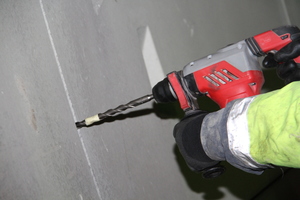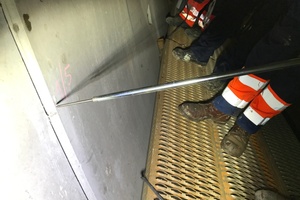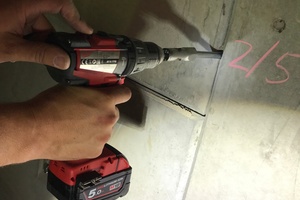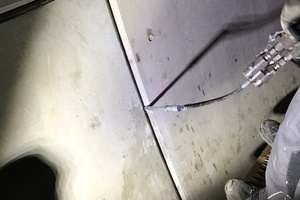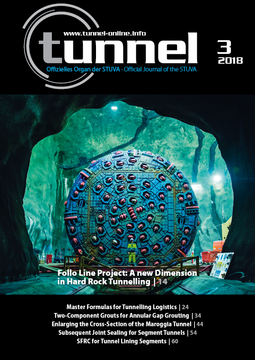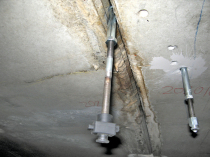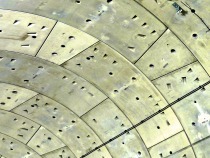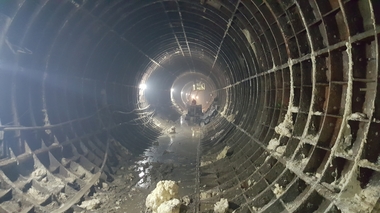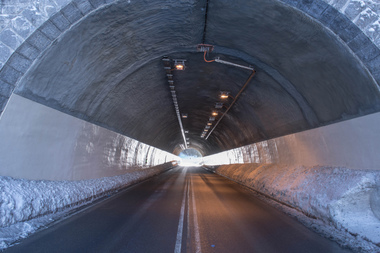New Joint Sealing Process for Segment Tunnels
Leaking joints between construction elements are a known problem with engineered structures below ground. This also affects segment linings constructed with tunnel boring machines. If subsequent waterproofing grouting is required, targeted joint sealing through the gasket is an effective and cost-saving alternative to laborious concrete drilling, which normally has to be undertaken to seal leaks. The first positive experience with the implementation of this process could be achieved with subsequent sealing of the segment lining of the German Finne Tunnel in 2011.
Targeted Sealing of Leaks in Segment Linings
In targeted sealing of leaks, the direct route through the joints between segment linings is used in order to drill through the gasket and inject grout on the water side through it. In this way the sealing effect of the grout in the joint canal between the segments can be achieved more precisely than with inclined drilling through the concrete of the segments.
In contrast to conventional procedures, the installer only has to open the unreinforced segment joint with an 18 mm hole in the concrete in order to reach the segment gasket (Fig. 1). The amount of drilling work is thus considerably reduced and the former problem of drilling being obstructed by the reinforcement is completely solved.
Much more laborious inclined drilling through the reinforced concrete and the subsequently necessary concrete repair – the segment concrete is of course an essential part of the waterproofing system – are now unnecessary. From experience with conventional inclined drilling, correct positioning is always a problem – associated with uncertain material consumption and sealing success.
The concrete cover in the face surfaces of the segment, which in our experience on projects is normally ample, does not require any repair work after drilling an 18 mm diameter hole through the segment joint, and the concrete hole can remain untreated after grouting.
Is it actually permissible to drill through Segment Gaskets?
The statement of an article in this magazine [1] (issue 3/2013) that drilling through a segment gasket is no longer a taboo, is decisive. This is backed up with extensive and understandable arguments by authors with experience in tunnelling. The present experience shows that even with great force used to drill through the segment joint to the gasket, no unintentional drilling through of the gasket has to be feared.
The Injection Drilling Needle as the latest Variant for targeted subsequent Joint Sealing
Now a tool has been used for the targeted subsequent sealing of joints, which combines all functions necessary for drilling through the segment gasket, then injecting grout and permanently closing the drilled hole against water under pressure.
Fig. 2 shows the injection tool, hereafter called „injection drilling needle“, and the associated grouting tube, into which the needle is screwed clockwise. When the segment gasket is penetrated by this 3–5 mm thick stainless steel needle, the sealing material is only displaced, and no material is removed as when drilled with a cutting action. The compression of the gasket inherent in the process is additionally increased so that it is impossible for the needle to be pushed out by water pressure acting from outside [2]. The working steps necessary for the use of the injection drilling needle are described below [2]:
1. Drilling in the Injection Drilling Needle
The injection drilling needle screwed onto the injection tube is pushed into a hole previously drilled until it meets the gasket (Fig. 2). Then it is screwed with light pushing into the gasket, using a cordless drill with an adapter, until it reaches the water side (Fig. 3).
2. Injecting the Joint and Selection of suitable Grouts
The grouting is carried out with very low grouting pressure in comparison to conventional concrete grouting since the intention this is the targeted filling of a joint space (Fig. 4). The compression pressure of the installed gasket represents the maximum possible grouting pressure into the joint; the gasket here plugs the joint to the inside and should not be overpressured. The progress and distribution of the selected grout can be controlled through the emergence of material at the adjoining packers.
Due to the expected shifting in the rock mass and the associated movement or settlement of the structure, elastic grouting materials capable of extension should generally be used. Particularly suitable are acrylate gels and elastic polyurethanes. These grouts should have a fitness for purpose certificate for injection into reinforced concrete, e.g. according to EN 1504-5, national technical approval or the new DIBt technical report. Since contact with the groundwater is probable during injection, groundwater hygiene suitability should be verified, e.g. according to DIN 19631:2016. Successfully used grouting materials are acrylate gels Rubbertite/Polinit or Variotite/Polinit as well as the elastic two-component polyurethane resin Pur-o-Crack. These are described for example in the German technical bulletin “ABI-Merkblatt” [3].
3. Removal of the Injection Tube
After completion of the injection process, the injection tube can be removed. It is not necessary to wait until the injected material has hardened since the injection drilling needle is equipped with a one-way valve and remains in the hole after grouting as a lost tool and closes it permanently and watertight. This permits the installer to change to the next injection point without waiting for the hardening of the injected material, similarly to a single-use packer, with the injection tube simply being unscrewed from the injection needle.
Experience with the Use of the Injection Drilling Needle
The targeted subsequent sealing of joints that we have carried out until now and newly with the injection drilling needle can be described as thoroughly positive.
The preparatory concrete drilling into an unreinforced segment joint are much simpler to carry out than the alternative of drilling through the reinforced segment concrete, whether as an inclined hole or parallel to the joint. Grouting works at the Rastatter Tunnel showed that the joint has to be drilled about 35 cm deep into a 50 cm segment, which can be done in less than two minutes.
The injection drilling needle can be bored through the segment gasket easily using a cordless drill with slight pressure. Due to the compression of the segment gasket, the needle sits fast and watertight in the gasket; unintended pulling out is thus impossible.
The most important point in the view of the author is however that the injection drilling needle is never the limiting element regarding flow measurements. The lower grout quantities compared to the classic „veiling“ can be injected at any time with very low grouting pressures directly into the leaking joint area.
When a grouting tube with a valve opener (this temporarily makes the one-way valve ineffective), it is even possible to inject the grout from one injection drilling needle to the next. This intentional perimeter transport makes it possible to detect the flow direction of the grout – a control method for the installer, which contributes to the optimisation of the grouting result.
The contractor does not have to accept any limitations in comparison to grouting with a steel packer. In the view of the authors, it can therefore only be a matter of time until targeted subsequent sealing of joints using the injection drilling needle becomes established as the state of the technology.

